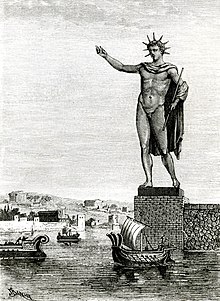
The Colossus of Rhodes (Ancient Greek: ὁ Κολοσσὸς Ῥόδιος, romanized: ho Kolossòs Rhódios; Modern Greek: Κολοσσός της Ρόδου, romanized: Kolossós tis Ródou)[a] was a statue of the Greek sun god Helios, erected in the city of Rhodes, on the Greek island of the same name, by Chares of Lindos in 280 BC. One of the Seven Wonders of the Ancient World, it was constructed to celebrate the successful defence of Rhodes city against an attack by Demetrius I of Macedon, who had besieged it for a year with a large army and navy.
According to most contemporary descriptions, the Colossus stood approximately 70 cubits, or 33 metres (108 feet) high – approximately two-thirds of the height of the modern Statue of Liberty from feet to crown – making it the tallest statue in the ancient world.[2] It collapsed during the earthquake of 226 BC, although parts of it were preserved. In accordance with the Oracle of Delphi, the Rhodians did not rebuild it.[3][4] John Malalas wrote that Hadrian in his reign re-erected the Colossus,[5] but he was mistaken.[6] According to the Suda, the Rhodians were called Colossaeans (Κολοσσαεῖς), because they erected the statue on the island.[7]
In 653, an Arab force under Muslim general Mu'awiya I conquered Rhodes, and according to the Chronicle of Theophanes the Confessor,[8] the statue was completely destroyed and the remains sold;[9] this account may be unreliable.[10](pp 179–186)
Since 2008, a series of as-yet-unrealized proposals to build a new Colossus at Rhodes Harbour have been announced, although the actual location of the original monument remains in dispute.[11][12]
- ^ Beekes, R.S.P. (2009). Etymological Dictionary of Greek. Brill. p. 740. ISBN 9789004174184.
- ^ Higgins, Reynold (1988). "The Colossus of Rhodes". In Clayton, Peter A.; Price, Martin Jessop (eds.). The Seven Wonders of the Ancient World. Psychology Press. p. 130. ISBN 9780415050364.
- ^ Strabo. Geography. 14.2.5.
- ^ "Why Have There Been Plans to Build a New Colossus of Rhodes? | Britannica". www.britannica.com. Archived from the original on 2024-02-07. Retrieved 2024-02-07.
- ^ Malalas, J. Chronography. Bks 10–11, 11.279.
- ^ Boatwright, Mary T. (2002). Hadrian and the Cities of the Roman Empire. Princeton University Press. p. 24. ISBN 978-0-6910-9493-9. Archived from the original on 2024-05-21. Retrieved 2020-10-02.
- ^ Suda. ka.1932.
- ^ Constantine VII Porphyrogenitos. De administrando imperio. xx–xxi.
- ^ "AM 6145, AD 652/-3". The Chronicle of Theophanes Confessor. Oxford, UK: Clarendon Press. 1997. p. 481.
- ^ Cite error: The named reference
Conrad-1996was invoked but never defined (see the help page). - ^ Williams, Kate (26 December 2015). "Rhodes reconstruction project will be a colossal gamble for Greece – but it might well pay off". The Guardian. Archived from the original on 27 December 2015. Retrieved 25 July 2016.
- ^ Bennett, Jay (7 January 2016). "There's a plan to rebuild the Colossus of Rhodes". Popular Mechanics. Archived from the original on 25 July 2016. Retrieved 25 July 2016.
Cite error: There are <ref group=lower-alpha> tags or {{efn}} templates on this page, but the references will not show without a {{reflist|group=lower-alpha}} template or {{notelist}} template (see the help page).